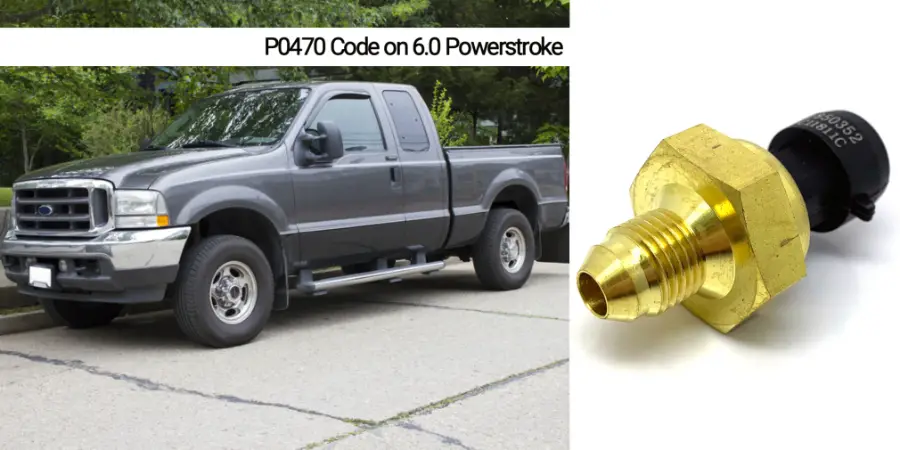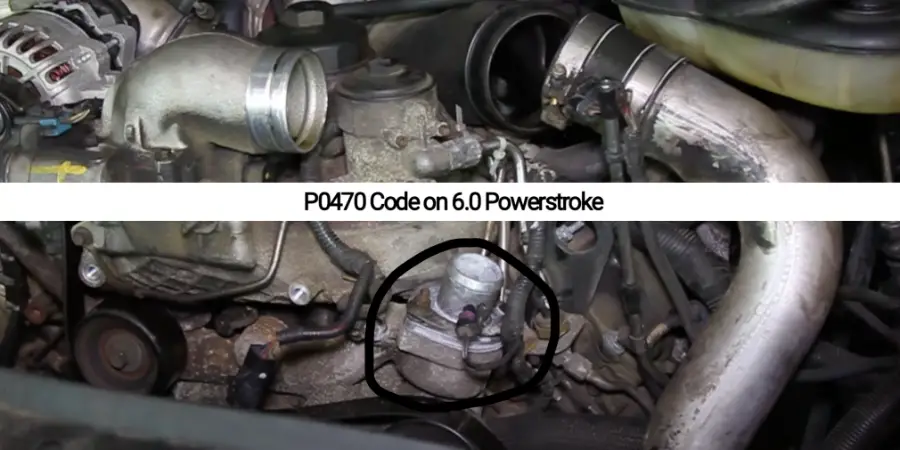
When your car is suddenly consuming too much fuel and you experience random stalling and backfiring, it’s very likely for your diagnostic tool to churn out the code P0470. If you’re unacquainted with codes, this can cause panic. But is this code worth stressing out over?
The P0470 code on a 6.0 Powerstroke represents a problem with the exhaust back pressure sensor. Usually, the code will indicate that there is a carbon buildup in the exhaust manifold. You can fix this code by removing the carbon buildup.
Whenever this code shows up, many car owners immediately think that a complete exhaust replacement is the way to go.
This article will explain why that may not be necessary by outlining the processes behind the error code. But first, I will take you through the steps on how to fix it, so you can get your car back in tip-top condition!
Here’s a step-to-step guide on how to fix the P0470 error code on the 6.0 powerstroke.
1. Locate the Exhaust Back Pressure Sensor
To fix the P0470 code, you have to clean the exhaust back pressure sensor (EBPS). One of the reasons for a faulty EBPS is the buildup of carbon in the exhaust manifold.
As a result, the ECU sends an alert to the car owner through the code P0470. I’ll go into more detail about how this carbon buildup occurs later in this article.
Unlike other sensors in the 6.0 Powerstroke, the EBPS is attached to an elongated tube which is also attached to the exhaust manifold. You should find the EBPS on the left side of the engine, beneath the coolant reservoir. However, you don’t need to remove the reservoir to access it.
You can loosen the flare nut using a crowfoot wrench, but a much better option would be a flare nut wrench, like this Williams Double Head Flare Nut Wrench from Amazon.com. It has great gripping and turning power, and what’s more, this brand has over 100 years of experience in developing industrial tools, so you can be sure that you are getting good quality.
2. Remove the Flare Nut Underneath the Reservoir
Beneath the reservoir, you will see a clamp that keeps the flare nut attached. Removing this clamp allows you to disconnect the electrical plug.
Once the flare nut is out, put it aside for the time being. You’ll need to examine it later, which I’ll discuss in an upcoming step.
3. Separate the Sensor From the Flare Nut
You can separate the sensor from the flare nut using a one-inch (2.5 cm) socket.
With the sensor removed from the tube, you can check if carbon has indeed built up by inspecting for soot and ash.
4. Clean the Tube With Tapping Oil
Begin cleaning the tube using a reliable tapping oil. With a few drops on one end of the tube, you should be able to see the buildup liquefy and go out the other end.
You can also further clean the tube by scraping off any remnants using a thin wire. Denatured alcohol may also be flushed down the tube to remove other impurities.
5. Apply Tapping Oil To the Sensor and Flare Nut
You can also use the tapping oil for the sensor and the flare nut.
Sometimes, the flare nut may have issues of its own as it’s prone to rust which can damage its threads, so tapping oil can help remedy this.
6. Inspect the Pipe Nipple for Damage
You may also have rusting and thread issues with the pipe nipple, in which case you can either clean it or order a replacement from Ford’s official website.
To prevent corrosion and other thread problems in the future, you may apply anti-seize grease to the pipe nipple, as well as the flare nut.
7. Reattach the Pipe Nipple, Tube, and Flare Nut
Everything is now set for re-attachment. Carefully place the pipe nipple on the exhaust manifold and use a socket to tighten the placement.
You can now install the tube. The upper part of the tube should be connected directly to the sensor, which you can plug in easily using your hands. Use the socket to attach the lower part of the tube (with the flare nut) to the pipe nipple.
Then, you can tighten the connection of the nut to the nipple using a torque wrench.
With the exhaust back pressure sensor cleaned, you can take your vehicle out for a spin to see if the problem still persists.
How the P0470 Code Is Produced

Your Powerstroke isn’t run by fuel alone. It also sucks in the surrounding air in the atmosphere to achieve high-quality performance.
The dominant elements in our atmosphere are nitrogen at 78% and oxygen at 21%. The intake manifold, which stores the sucked-in gas, works with mostly nitrogen and oxygen atoms.
The sucked-in gas then travels to the cylinders and combustion chambers, where the air is compressed and heated.
Nitrogen and Oxygen Form Nitrous Oxide
Under high temperatures, nitrogen and oxygen atoms decompose and fuse together to form nitrous oxide. The problem with nitrous oxide, however, is that it harms the environment.
In response, car manufacturers try to limit emissions, partly also because they have to. Most countries impose emission standards for car manufacturers, after all.
Exhaust Gasses Travel Through Coolant Pipeline
When the gas exits the combustion chambers, it’s transferred to the exhaust manifold, ready to be deployed back into the atmosphere.
However, your engine is designed so that excess exhaust gasses find their way back into the intake manifold through a small pipe along the exhaust manifold.
This small pipe is surrounded by coolants. When the excess exhaust gasses pass through this pipe, they’re naturally cooled down.
A valve opens up at the end of this pipe to allow the cooled air to exit. On the other side of this valve is the intake manifold.
Nitrous Oxide Gas Production Decreases
This means that both the surrounding air and the cooled air can travel back into the combustion chamber through the opened valve.
With the cooled air now in the combustion chamber, naturally, the temperature lowers, lowering the rate of nitrogen and oxygen decomposition.
As such, the amount of nitrous oxide gasses also lessens, allowing easier compliance with national and global emission standards.
Exhaust Back Pressure Sensor Monitors Gas Pressure
The gasses in the exhaust manifold then pass through a diesel particulate filter — which removes any foreign objects — before they move into the catalytic converter.
Do note that the exhaust gas, despite passing through several of your engine components, isn’t necessarily pressurized well enough to guarantee exit via the mufflers.
Exhaust back pressure refers to the pressure buildup in the exhaust that prevents the expulsion of the exhaust gasses. The exhaust back pressure sensor (EBPS) is the component dedicated to seeing these gasses out.
To do this, it produces an atmospheric pressure reading which gets sent to the engine control unit (ECU).
ECU Operates Based on EBPS Reading
The ECU sort of acts like the brain of the engine. From the reading it gets from the EBPS, it dictates all other components to attain the pressure needed to expel the gasses. However, the problem comes in with the intake manifold, which has its own sensor.
The manifold pressure sensor (MAP) also reads the pressure from the atmosphere as it sucks in the air. Confusion arises when the EBPS and MAP report wildly different readings and the ECU cannot determine which components to modify to unite the two sensors.
Consequently, the entire nitrogen oxide diversion process is disturbed, and the exhaust gasses cannot exit the muffler properly. This leads to a buildup of carbon in the exhaust manifold. As a result, the ECU produces the code P0470.
Symptoms of a Bad Exhaust Back Pressure Sensor
Sensors such as the EBPS tend to be very sensitive engine components. For example, issues with the injector control pressure (ICP) sensor tend to produce the error P1211. Read more about this here.
While the P0470 code can be attributed to a bad EBPS, other components may often prevent the MAP and the EBPS from giving matching readings.
So, if you want to be sure that the issue is the EBPS, look out for these signs:
There Is Black Soot Coming Out of the Exhaust
As you now know, the EBPS plays an important role in determining the pressure needed to expel exhaust gasses.
With a faulty or damaged EBPS, the exhaust gasses can build up long enough in the manifold to become contaminated with soot and other foreign materials.
This is why you may notice smoke or soot from the exhaust when you power up your engine.
High Engine Temperature
Because the EBPS is heavily involved in using coolants to regulate the engine’s temperature, it is very likely that a faulty EBPS will disrupt the cooling process and trap the heat from the combustion chambers.
As a result, excess exhaust gasses from the manifold cannot proceed to the coolant pipeline because of a lack of the right pressure. Consequently, the various engine components overheat.
Conclusion
A complete replacement of the EBPS is unnecessary for the P0470 code. The code most likely means there is a carbon buildup in the exhaust manifold that needs to be cleaned.
With the right tools and patience, the entire cleaning process should take about 15 minutes. After that, you can ride your vehicle again in peace.
